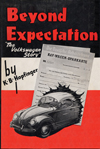|
|
Beyond Expectation
Price: $0.00
|
©2002 Robert Bentley, Inc. We encourage visitors to link to this page if you’d like to share this information with others. Please do not copy this excerpt to other web sites. It is protected by copyright and represents significant resource investment by Bentley Publishers.
(2 page excerpt)
INTRODUCTION
The date was February 12, 1933, when some of the remaining uncensored German newspapers reported that the newly elected Chancellor, Herr Adolf Hitler (who when seen in public in those days was wearing civilian clothes appropriate to the occasion), mentioned while opening the Berlin Automobile Exhibition on the previous day, that his government would support any plans which would ensure cheap cars for the man in the street.
Somewhat different, however, was Hitler’s attitude on this subject when opening the 1934 Berlin Automobile Exhibition, already wearing a military style uniform. No sooner had he started his speech, than he stated agitatedly: " It can only be said with profound regret that, in the present age of civilization, the ordinary hard-working citizen is still unable to afford a car, a means of up-to-date transportation and source of enjoyment in the leisure hours. One must have courage to face problems and what cannot be solved within a year may well become an established fact within ten years." While for the German Press, already experiencing national socialist censorship, this speech became headline news, the foreign Press paid no attention to such an outburst of political propaganda.
At the opening of the 1935 Berlin Automobile Exhibition Hitler mentioned, no longer in the guise of a political agitator, but triumphantly that, thanks to the abilities of an outstanding designer and his staff, the initial plans of a Volkswagen had been completed and the first prototypes would be tested within four months. (In fact it took 11 years to complete the first three prototype Volkswagen.) Continuing amidst prolonged and almost hysterical cheers, he continued by saying: " There is no longer any reason why the German people in the near future will not be able to enjoy cars costing no more than a better-quality motor-cycle." This statement certainly aroused the attention of the Press throughout the world. What sort of a car was this " Volkswagen " to be? Who was the designer with outstanding abilities? These were questions which puzzled not only people abroad, but also in Germany. Strict controls and censorship of the Hitler régime did little towards satisfying their curiosity. There were, of course, rumours of what the car was to look like and what its performance was to be. Any unusual-looking vehicle seen late at night was thought to be the prototype of a Volkswagen, while others believed that if a Volkswagen was to be tested on public roads at all, it would be bearing some Ruritanian registration plates in an endeavour to shield its identity. Although the shroud of secrecy surrounding the " Volkswagen " started to grow daily, it was soon learned that the " outstanding designer " was none other than Dr. Ferdinand Porsche. Then his name was hardly known abroad, for after all, the names of car designers only become famous when their brainchild bears their name and is produced in numbers, this being synonymous with financial success. Porsche’s reputation as an inventive designer and a one-time successful racing driver was well known in Germany, Austria and the central European countries. Several cars which he designed when still a young man had found their way into museums long before his name was ever mentioned in association with the Volkswagen.
End of excerpt
©2002 Robert Bentley, Inc. We encourage visitors to link to this page if you’d like to share this information with others. Please do not copy this excerpt to other web sites. It is protected by copyright and represents significant resource investment by Bentley Publishers.

![[B] Bentley Publishers](http://assets1.bentleypublishers.com/images/bentley-logos/bp-banner-234x60-bookblue.jpg)
